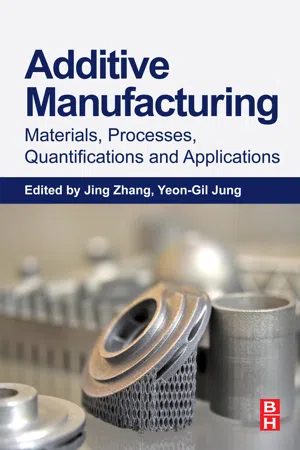
Additive Manufacturing: Materials, Processes, Quantifications and Applications
- 362 pages
- English
- ePUB (mobile friendly)
- Available on iOS & Android
Additive Manufacturing: Materials, Processes, Quantifications and Applications
About This Book
Additive Manufacturing: Materials, Processes, Quantifications and Applications is designed to explain the engineering aspects and physical principles of available AM technologies and their most relevant applications. It begins with a review of the recent developments in this technology and then progresses to a discussion of the criteria needed to successfully select an AM technology for the embodiment of a particular design, discussing material compatibility, interfaces issues and strength requirements. The book concludes with a review of the applications in various industries, including bio, energy, aerospace and electronics.
This book will be a must read for those interested in a practical, comprehensive introduction to additive manufacturing, an area with tremendous potential for producing high-value, complex, individually customized parts. As 3D printing technology advances, both in hardware and software, together with reduced materials cost and complexity of creating 3D printed items, these applications are quickly expanding into the mass market.
- Includes a discussion of the historical development and physical principles of current AM technologies
- Exposes readers to the engineering principles for evaluating and quantifying AM technologies
- Explores the uses of Additive Manufacturing in various industries, most notably aerospace, medical, energy and electronics
Frequently asked questions
Information
Overview of additive manufacturing process
Abstract
Keywords
1. Additive manufacturing technology
- • Binder jetting: A process by which a liquid bonding agent is deposited onto a bed of powder. Can be used with gypsum, sand, glass, metal, and several others.
- • DED: In which metal, as a powder or wire feedstock, is fed in front of an energy source, such as an electron or laser beam, mounted on a multiaxis robotic arm. The material is melted onto a substrate layer-by-layer. Used with metals such as titanium and cobalt-chrome.
- • Material extrusion: A material is deposited from an extruder onto a substrate. Typically, a thermoplastic filament is melted by a heating mechanism and extruded through a hot end. However, the same process can be used with viscous materials such as concrete, clay, organic tissue, or even food.
- • Material jetting: Specialty printheads, such as piezoelectric printheads similar to those found in 2D inkjet printers, spray a liquid material onto a substrate. Most often, this material is a photosensitive plastic resin (also known as a photopolymer) that is then hardened with an ultraviolet (UV) light.
- • Powder bed fusion: This is a process by which an energy source, such as a laser or electron beam, is directed at a bed of powder to heat the individual particles until they melt together. Usually, this technology is associated with metals such as titanium, as well as plastics such as nylon.
- • Sheet lamination: In this process, sheets of material are fused together, with the desired shape etched into each shape. The final object is then removed from the block of bound sheets. This rare 3D printing process is currently most not only often used with paper, but also with metal and plastics.
- • Vat photopolymerization: A vat of photopolymer resin is exposed to an energy source, such as a laser beam or digital light projector, which hardens the material layer-by-layer. This process is usually associated with thermoset plastics.
Table of contents
- Cover
- Title page
- Table of Contents
- Copyright
- Contributors
- 1: Overview of additive manufacturing process
- 2: Additive manufacturing processes and equipment
- 3: Additive manufacturing of metallic materials
- 4: Additive manufacturing of ceramic components
- 5: Characterization of fused deposition modeling polymeric structures using embedded fiber Bragg grating sensors
- 6: Quantification and certification of additive manufacturing materials and processes
- 7: Multiscale multiphysics modeling of laser powder bed fusion process
- 8: Additively manufactured metals for medical applications
- 9: Additive manufacturing for biofabricated medical device applications
- Index